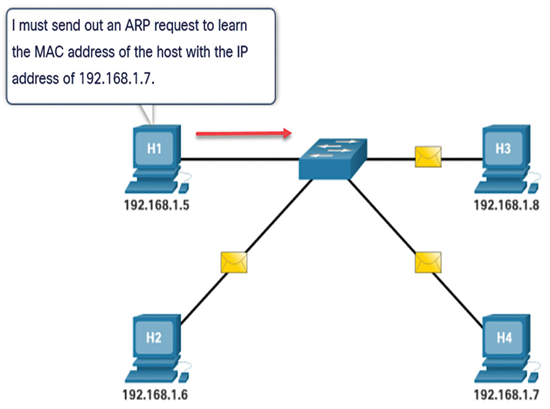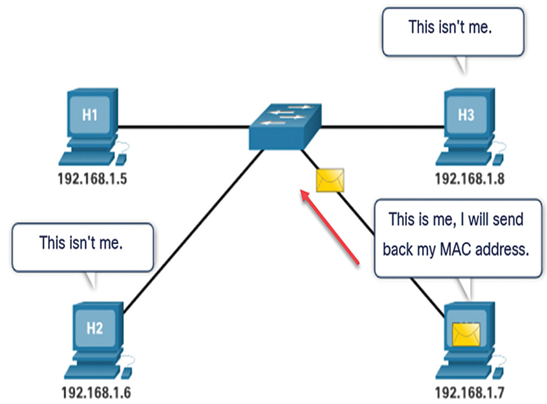When a packet is sent to the data link layer to be encapsulated into an Ethernet frame, the device refers to a table in its memory to find the MAC address that is mapped to the IPv4 address. This table is stored temporarily in RAM memory and called the ARP table or the ARP cache.
The sending device will search its ARP table for a destination IPv4 address and a corresponding MAC address.
• If the packet’s destination IPv4 address is on the same network as the source IPv4 address, the device will search the ARP table for the destination IPv4 address.
• If the destination IPv4 address is on a different network than the source IPv4 address, the device will search the ARP table for the IPv4 address of the default gateway.
In both cases, the search is for an IPv4 address and a corresponding MAC address for the device.
Each entry, or row, of the ARP table binds an IPv4 address with a MAC address. We call the relationship between the two values a map. This simply means that you can locate an IPv4 address in the table and discover the corresponding MAC address. The ARP table temporarily saves (caches) the mapping for the devices on the LAN.
If the device locates the IPv4 address, its corresponding MAC address is used as the destination MAC address in the frame. If there is no entry is found, then the device sends an ARP request, as shown in Figure 24-2.

Figure 24-2 H1 Sends a Broadcast ARP Request
The destination responds with an ARP reply, as shown in Figure 24-3.

Figure 24-3 H4 Sends a Unicast ARP Reply
Video – ARP Request (24.1.3)
An ARP request is sent when a device needs to determine the MAC address that is associated with an IPv4 address, and it does not have an entry for the IPv4 address in its ARP table.
ARP messages are encapsulated directly within an Ethernet frame. There is no IPv4 header. The ARP request is encapsulated in an Ethernet frame using the following header information:
• Destination MAC address — This is a broadcast address FF-FF-FF-FF-FF-FF requiring all Ethernet NICs on the LAN to accept and process the ARP request.
• Source MAC address — This is MAC address of the sender of the ARP request.
• Type — ARP messages have a type field of 0x806. This informs the receiving NIC that the data portion of the frame needs to be passed to the ARP process.
Because ARP requests are broadcasts, they are flooded out all ports by the switch, except the receiving port. All Ethernet NICs on the LAN process broadcasts and must deliver the ARP request to its operating system for processing. Every device must process the ARP request to see if the target IPv4 address matches its own. A router will not forward broadcasts out other interfaces.
Only one device on the LAN will have an IPv4 address that matches the target IPv4 address in the ARP request. All other devices will not reply.
Refer to the online course to view this video.
